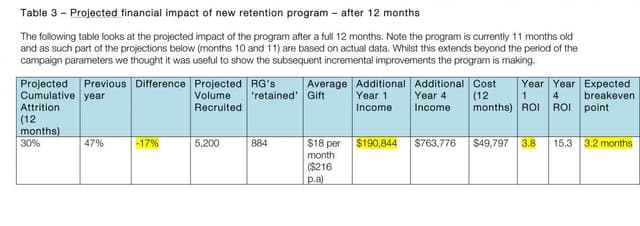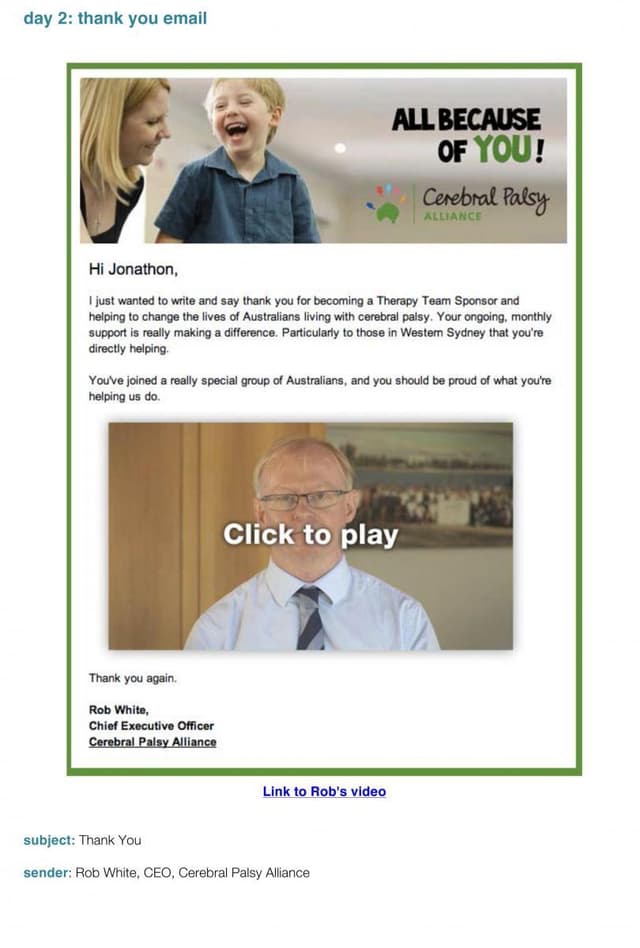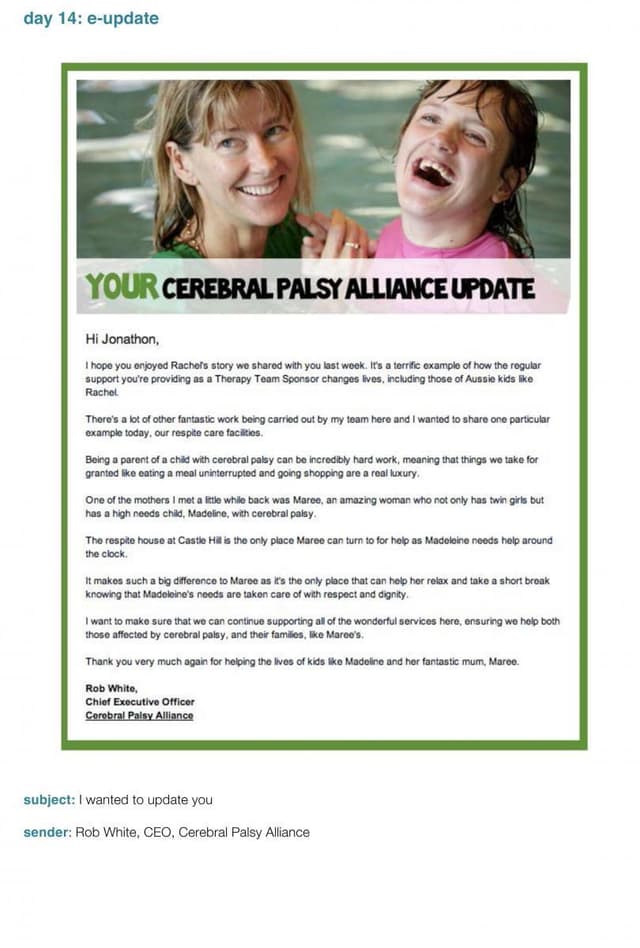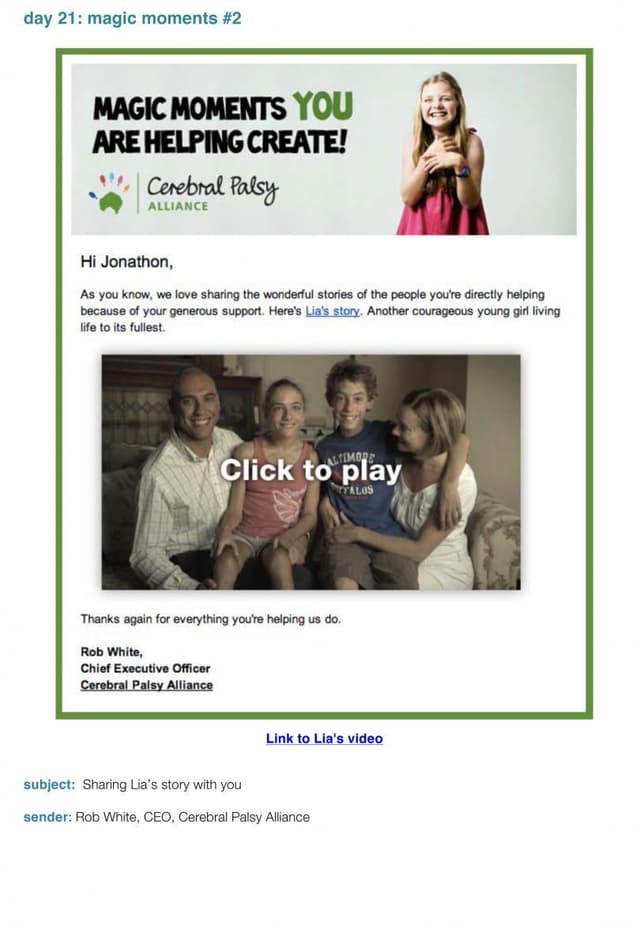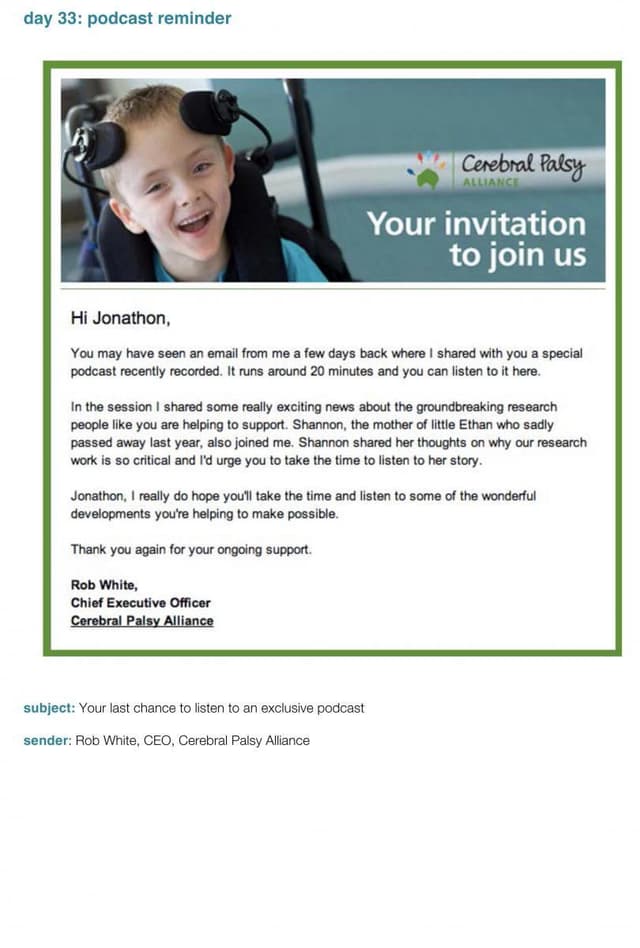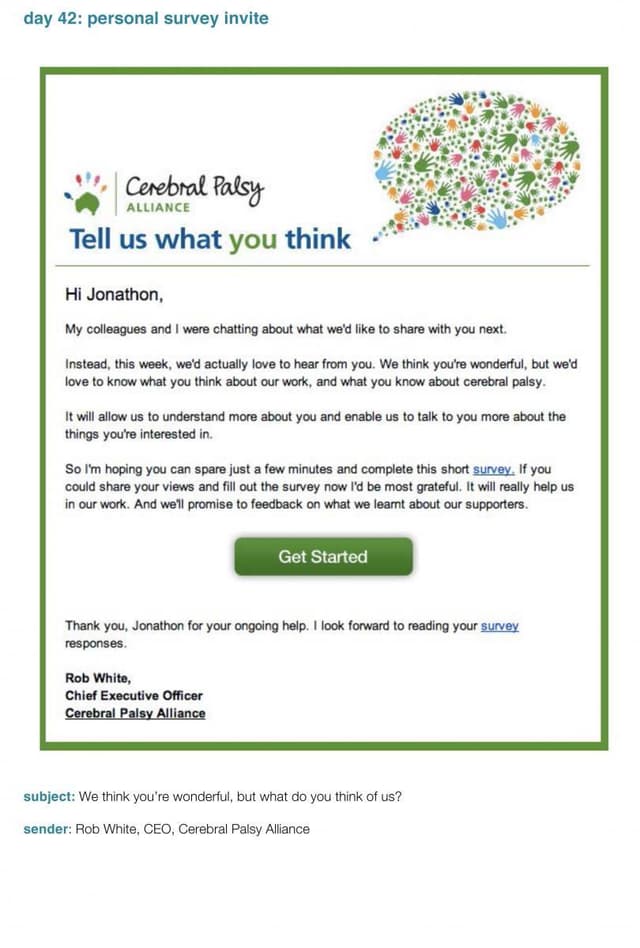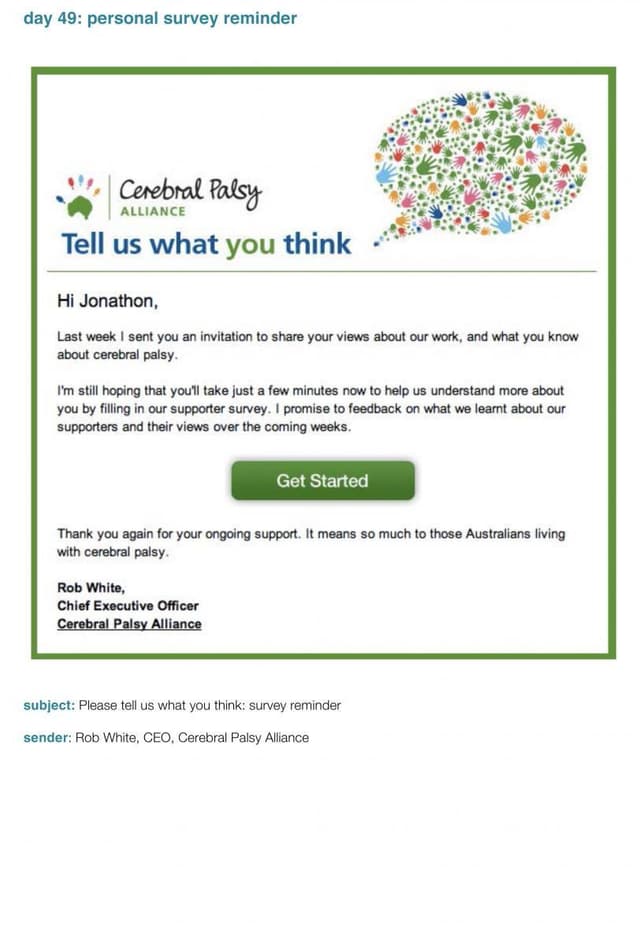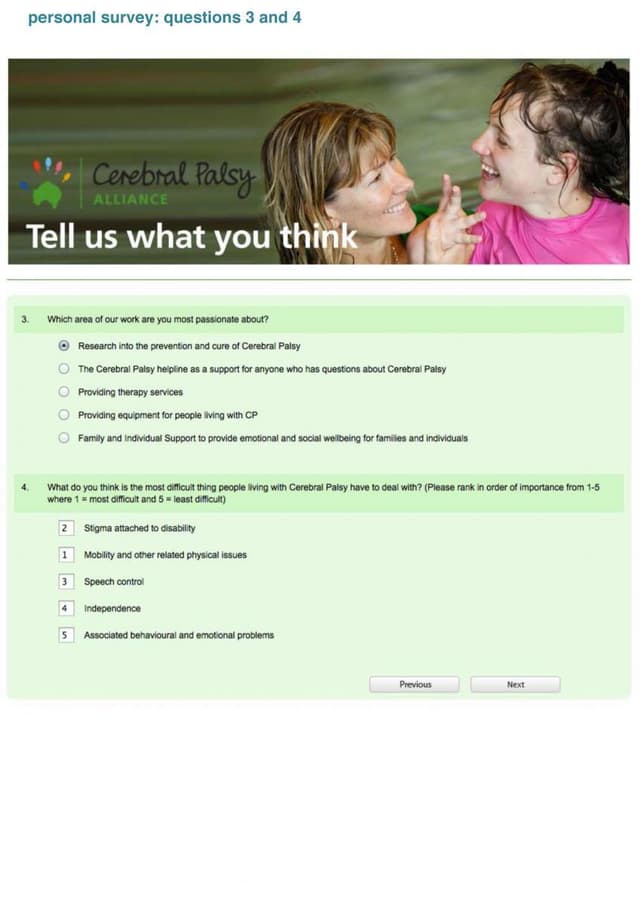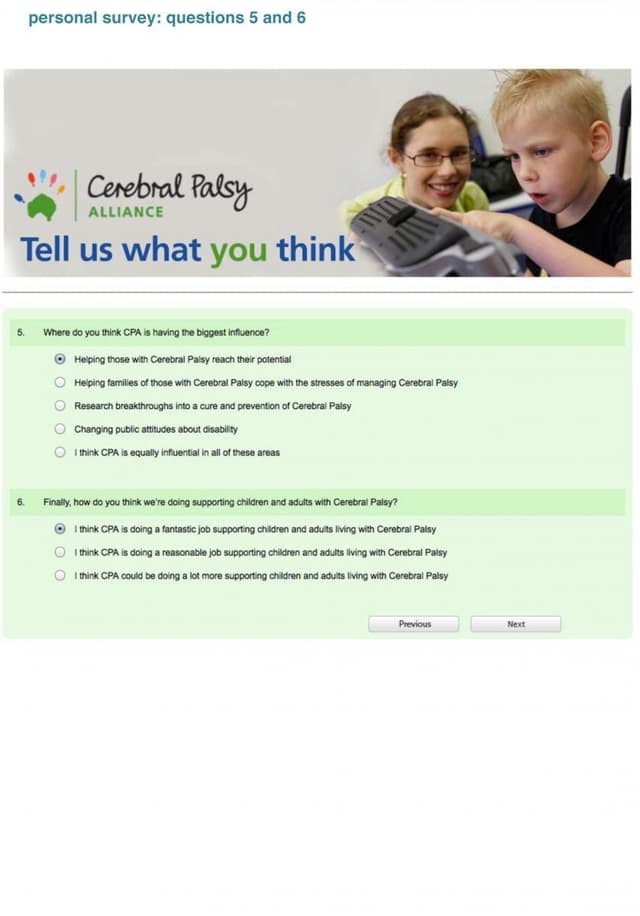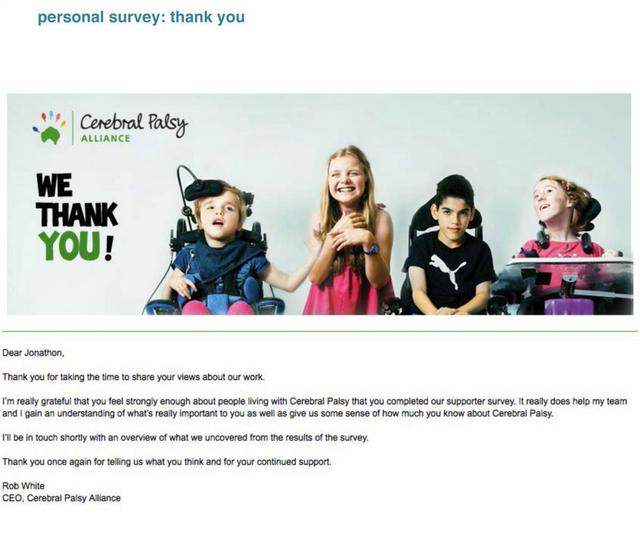How I wrote it: Cerebral Palsy Alliance’s multimedia, email and video
- Written by
- Jonathon Grapsas
- Added
- March 02, 2013
So far in the ‘how I wrote it’ series, we have focused on the traditional form of campaigning. In other words, packages only using the written word. Here we look at a communication package that uses multimedia, email and video.
Here Jonathon Grapsas talks to Fergal about his work for the charity Cerebral Palsy Alliance. Jonathon is based in Australia where he works for a number of local charities.
 View original image
View original image
‘About 18 months ago Cerebral Palsy Alliance (CPA) came to us with a challenge. Like many Australian charities they were recruiting large volumes of regular givers face to face, and, like most charities, they were struggling to hang on to them.
‘The average attrition rate of face-to-face donors in Australia during the first year was about 40 percent. Cerebral Palsy Alliance was experiencing a year-one attrition of 47 per cent – in other words, the charity was losing almost one in two donors.
‘We looked at what they were doing and discovered they were dealing with donors aged from their mid-twenties to mid-thirties. They were treating them as if they were more traditional donors in their mid-sixties and over,’ Jonathon continued.
Cerebral Palsy Alliance had been using traditional means to communicate with donors including mail-shots, brochures and newsletters – everything delivered through the mail. However, the charity’s target audience was, in fact, a vast online community. It was a classic scenario of trying to fit a square peg in a round hole.
Research showed that more than half of Australians use a smartphone or tablet on a daily basis – Jonathon could see there was a major disconnect between the charity’s communications strategy and its donors’ lifestyles.
‘So you’ve got a really mobile, engaged audience and yet all you are doing is sending them stuff in the mail,’ he said. ‘The reality is that most of the stuff just wasn’t being looked at, read, or even acknowledged. There was no doubt that was contributing significantly to the fact that almost half the donors were dropping out – around half in the first three months.’
 View original image
View original image
Jonathon and the Cerebral Palsy Alliance team sat down and took the decision to scrap their communications approach and, instead, to ‘think mobile’. They began to work on ways of communicating online, assuming that donors would be accessing information on a mobile device.
However, they didn’t want to lose the impact of face-to-face campaigning. Jonathon knew from experience that street campaigning usually leads to passionate and engaged conversation with the public, even if only two new donors sign up on an average day. However, enthusiasm for the charity can quickly wane if there is no follow-up after this initial high-energy contact.
‘The relationship inevitably goes down from an extreme high after signing-up. The donor hits a low because nothing happens. They might get a welcome call a couple of days later, but invariably the relationship tails off quickly,’ Jonathon said.
‘Before, CPA was sending a welcome brochure and maybe a quarterly newsletter – and that was about it. So you had this amazing conversation on the street about what you were doing to help the lives of people living with cerebral palsy. And then nothing really happened – they had a very low key follow-up.’
Jonathon realised they needed another approach – one focused on the relationship. ‘We didn’t want the donor to have a lull in their relationship with CPA. Quite the opposite: we wanted to make sure we were constantly reminding them of why they were doing such a great thing. We wanted them to be as excited as the moment they signed up. We wanted them to feel inspired and know they could trust that CPA was doing a good job.’
To achieve this, the team set about developing a plan for creating videos, podcasts and an email campaign. They needed to decide on the frequency of the communications – which would involve a little trial and error.
‘Our research showed that the first three months are the real trigger points for attrition. So it was absolutely essential to continuously remind donors during this period that they were doing something wonderful. We figured that communicating once a week, on average, was about right – not too much but not too little,’ Jonathon explained.
They put together a multi-faceted communication programme – a mobile engagement plan, which included emails, podcasts, welcome brochures, invitations to take part in surveys and other media – for the first three months after a donor signed up. After this they scaled back the contact to once every three or four weeks, knowing that if they had managed to keep a donor for three months, they were likely to continue giving after this time.
‘We wanted to give people an opportunity to engage with us in a variety of different ways,’ said Jonathon. ‘We included videos from the CEO saying thank you. For example, we had a ‘magic moment’ series of videos – a collection of three-minute stories sharing the lives of people who had been touched as a result of regular support. We sent emails, we carried out surveys. We made an annual phone call to registered donors, operated by external calling agencies, encouraging them to upgrade their membership.’
On average, CPA was recruiting in the region of a hundred new donors each week through conversations with people on the street. The strategy of high-frequency contact meant the CPA had to produce 2,500 individual communications over the course of the year, and an automated system would be needed to manage the volume.
The automated system was designed to send out emails to signed-up donors at prescribed intervals. At first they were sent every few days, then eventually reduced to every few weeks. Having invested in the automated system, the team was keen to make it pay for itself. But, as they didn’t have any experience with the platform, it was a matter of waiting to see what the results would yield.
The initial results have been very good. Just over a year in, the rate of attrition has fallen from 47 percent to around 37 percent. The results far surpassed their expectations.
Jonathon felt one of the most effective tools in retaining donors was the use of video. The magic moments series was the most compelling communication CPA had used with its donors, so they sent out feel-good messages early on in the strategy. They could also tell that nearly half the respondents opened the videos, as opposed to response rates of around 30 percent using other media.
Then there was the element of surprise.
‘We made sure there was never a lull in the relationship. Donors never knew what was coming next. One day they might receive a video and then the next they were invited to complete a survey. The day after that, or even a week later, they were sent a podcast, and the week after that they received an SMS. We were making sure that people didn’t really know what was going to come next,’ explained Jonathon.
The team had to try to put themselves in the shoes of their donors to see how to structure their media strategy.
‘We worked in reverse. It was more about, “how do we want this person to feel?” and then we worked out what was the best way to do that. So if we wanted them to feel inspired, we sent them a video story. If we wanted them to feel they could trust us, we sent a written story about someone who had been helped. If we wanted them to feel we were listening to them and that they were part of a special group, we invited them to fill in a survey.’
The team admits it was an exercise in trial and error. Lacking experience in this type of campaign, they closely monitored the reaction of donors – they were apprehensive they could have been sending too much. Thankfully they learned that their approach was working and that people were responding positively to the videos, emails and texts.
Jonathon described how developing the strategy remained very fluid in the early days.
‘We developed probably the first 50 to 60 days’ worth of content up front because, as you can imagine, we didn’t want to develop an email or video that was going out in month 12, because by then it would actually have been 14 months old. So we sat down every month, looked at what we had got and then worked out what we were going to send people.
‘We looked at what was working and then created more content around what people liked to make sure we gave them what they were really interested in. It’s an evolving process.’
Part of the campaign rested on the effectiveness of emails. Jonathon and his team decided it was not enough to simply bombard donors with random emails, but rather to use them as a means to support other areas of the strategy, such as a video or podcast.
‘Email isn’t particularly great as an acquisition tool, but it’s really good at retention – for example, sharing updates and other news. It’s also good as a pre-appeal to let someone know there’s a really important appeal going in her or his letterbox, or as a follow-up to remind her she hasn’t responded and we haven’t hit our targets yet.’
Harking back to traditional means of communicating, Jonathon appreciated that people often don’t look beyond what is printed above the fold on a letter. His team did not assume that people would land on a webpage and automatically scroll down – they knew it was imperative to place the message at the top of the web page, just as with a conventional letter. He needed to make his message easy to view.
Once donors hit the landing page, CPA had free rein to invite them to watch a new video with a new message and a thank-you. It was a plan that obviously worked, as they soon discovered that nearly half the people hitting the landing page opened the video – a rate that far outstripped industry standards.
‘Cerebral Palsy Alliance is not and never will be an ‘A-list’ cause to support. This new communications pathway has transformed our profitability, relationship with donors and internal commitment that face-to-face fundraising is a number one growth area. Without the changes Flat Earth Direct made it’s questionable whether we’d still have support for investment.’
Marcus Blease, general manager markeing and international programs at Cerebral Palsy Alliance.
Their success continued, with attrition rates well below those from other campaigns.
‘We think people were sticking around after those first few months because in some respects, the offer is more important than the action itself. In other words it’s more important that we send them an email that says in the subject line, “Thank you very much, this is what your support is helping to do”, rather than whether they opened it.
‘I think that after a while we got to a point where people were looking at it and thinking, “Well I know these guys are sending me loads of really good stuff, I trust them, they’re doing good work and obviously they’re using my money appropriately.” So even though the opening rate has dropped off ever so slightly, they are still sticking around.’
Another tool the team used was to make their emails unique and easily identifiable. They developed ‘skins’ – themes – for their magic moment series.
‘For example,’ explained Jonathon, ‘the donor care updates had a skin that said, “it’s all because of you”. We tried to keep it really clean and simple, make it always about the donor. “These are the magic moments you’re helping to create and this is what you’ve helped us to do.”
‘Every time we sent out an email, we tried to use people’s faces – particularly kids’ faces. We know that people resonate more with children’s case studies, so we had a slant towards that. We also wanted to make the emails look genuine, so although each one was different, you could tell it was from CPA.
A similar approach was used for the videos.
‘We wanted to make videos that showed everyday life for people living with cerebral palsy and their families – the struggles they have.’
Jonathon and his team used videographers to develop the video content but half of it was existing footage re-edited, the other half shot from scratch. The results were good and Jonathon quickly realised that the enormous amounts of video footage could be adapted for different parts of the campaign, thereby cutting down on overall costs.
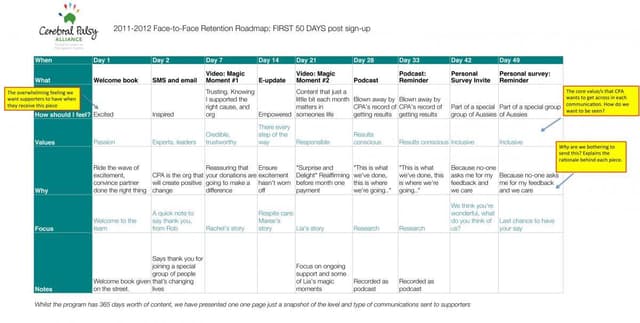 View original image
View original image
The risk of launching such a huge campaign using a relatively unknown technology was a big gamble for the team. They had to tread carefully to ensure they were reading feedback correctly and putting the right triggers in place at the right time to encourage donors to remain loyal. Fortunately their careful work paid off and the attrition rate slowed remarkably.
As Jonathon concluded, ‘We felt like we had nothing to lose because attrition was so poor, things couldn’t get worse – so perhaps there wasn’t that much risk. But as far as we know, right now we’re probably experiencing the lowest attrition rates in Australia.’



